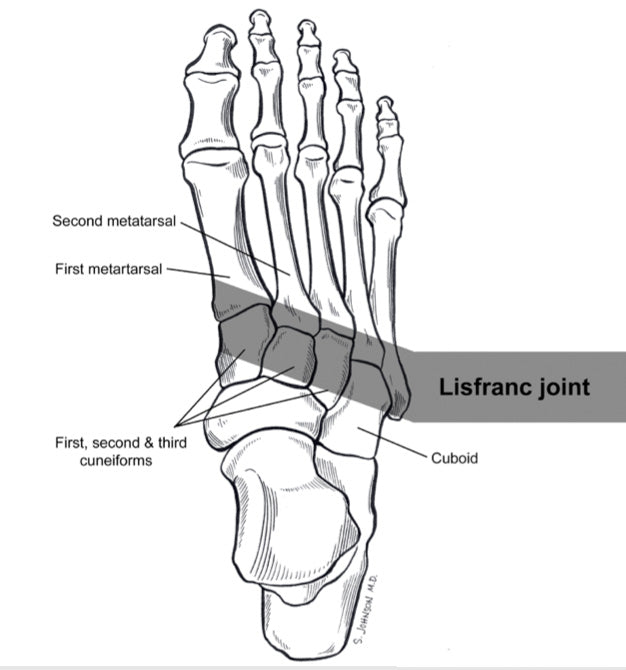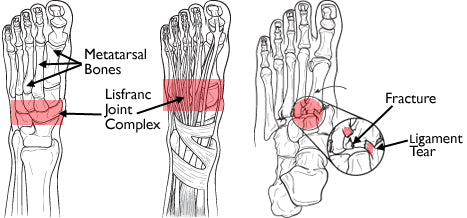Lisfranc Injuries & Fractures
What is a Lisfranc Injury?
The relatively non-descript “Lisfranc injury” refers to the fracture or dislocation of the bones or torn ligaments in the mid-foot region known as the Lisfranc joint. The name is derived from that of a French surgeon of the 19th century who observed this type of injury often during his time in the Napoleonic army, Jacques Lisfranc de St. Martin.
Lisfranc Joint Anatomy
To go into a bit more detail, Lisfranc’s joint refers to a cluster of small bones that form the arch on the top of the foot from which five metatarsal bones extend. These bones are held in place by a number of ligaments that run across and down the foot. Of note, there is no connective tissue between the first and second metatarsal, which makes it easier for a Lisfranc joint injury to occur in that area.
In terms of function, the Lisfranc ligament and bone structure is instrumental for transferring the force of the calf muscles to the forefront of the foot as well as for supporting and stabilizing the arch of the foot.

Lisfranc Fracture, Dislocation or Sprain
As noted previously, there is no ligament connecting the first and second metatarsal. This makes them more susceptible to Lisfranc fracture or Lisfranc dislocation due to a simple twist or fall. More specifically, a stumble over the top of the foot with the foot flexed downward, as one might experience when stepping in a hole, is often the culprit for injury to the mid-foot region. (Read about more common foot problems.)

Lisfranc injuries of this nature can be found among soccer and football players as well as in sports that use equipment in which bindings pass over the metatarsals, such as wakeboarding, snowboarding or windsurfing.
More severe instances of the Lisfranc foot injury that involve multiple fractures, torn ligaments or dislocated bones usually stem from direct, high-energy trauma, such as a fall from a height, dropping a heavy object onto the foot or being in a car accident.

Lisfranc Injury Symptoms
Some symptoms of a Lisfranc foot injury include:
- Pain at top of the foot
- Swelling
- Bruising at top and bottom of the foot
- Mid-foot tenderness
The pain associated with a Lisfranc sprain, fracture or dislocation typically worsens when standing or walking, and in some cases, the pain may be so severe that one cannot put weight on the foot.
If this condition is not treated, it can result in flat foot, arthritis or compartment syndrome, a condition characterized by the buildup of pressure in the muscles that over time can damage nerve cells and blood vessels.
Non-surgical Treatment for Lisfranc Sprain
When a Lisfranc injury MRI or physical exam reveals that an injury to the mid-foot does not include any fractures, major joint dislocations or complete ligament tears, one can usually treat the condition by following the steps of RICE and strictly following the doctor’s instructions not to put weight on the foot for six weeks. During this time, the person will have to wear a non-weight-bearing cast.
After that period, the individual will likely be transferred to a weight-bearing removable cast boot or a Lisfranc injury foot orthotic, such as a rigid arch support. Exercises may also be recommended as part of Lisfranc rehab to return strength and a full range of motion to the foot.
Lisfranc Surgery
But in instances when a Lisfranc’s fracture or subluxation (dislocation) of the joints is present or a ligament has been severely torn, surgery will likely be needed to realign the joint and return the bone fragments to a normal position. There are several ways of doing this including:
- Internal fixation surgery
- Fusion surgery
To repair a Lisfranc foot fracture or dislocation via internal fixation, a surgeon uses plates, pins, wires, and screws to the repair the damage. Three to five months after the surgery, some or all of the surgical hardware will have to be removed.

The fusion type of Lisfranc surgery involves a “welding” process to fuse the bones together so that they heal as a single bone. Pins and screws are usually used to help with this process and to enable foot function. Watch a video that explains what a Lisfranc injury is and the surgical procedure to repair it for more on this topic.
The Lisfranc injury rehab period for either type of surgery is a lengthy one that usually involves the patient wearing a non-weight-bearing cast boot for six to eight weeks, after which time he or she can switch to limited weight-bearing and walking with the help of a walking boot or a Post Op Shoe.
Eventually, the patient will transition back to use of a shoe. When this occurs, the individual will likely need a rigid arch support or stiff-arched shoe until he or she is fully recovered. Also, no impact activities will be allowed until all hardware from surgery has been removed from the foot.
Physical therapy will be needed to return a full range of motion and strength to the foot after the substantial period of inactivity required for Lisfranc injury recovery.










